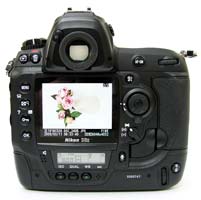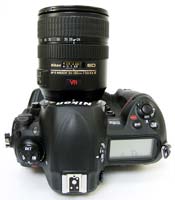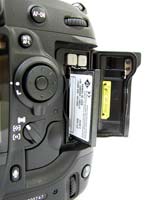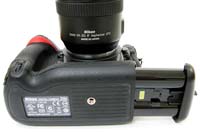The Nikon D3x is the highest resolution digital SLR camera currently available, offering a massive 24.6 megapixels courtesy of its full-frame FX format CMOS sensor. The D3x is largely based on the 12 megapixel D3 camera, retaining the same 51-point AF system, EXPEED engine with 14-bit A/D conversion and 16-bit image processing, 920,000-dot 3-inch LCD screen, and Live View. The main differences between the two are the reduced 50-6400 ISO range and slower 5fps continuous shooting speed offered by the D3x - plus the eye-watering price-tag of £5499.99 / €7728.00 / $7999.95, over twice as much as it’s closest rivals, the Sony A900, Canon EOS 5D Mark II and Nikon D3. Does the Nikon D3x offer enough features and sheer quality to justify its asking price? Gavin Stoker found out…
Ease of Use
Though most of us have gathered by now that pixel counts aren't everything, the biggest talking point of the range-topping, bank manager bothering Nikon D3x is indeed its resolution. Delivering an effective 24.5 million pixels from a specially developed FX format CMOS sensor, the solid-feel full frame DSLR doubles that offered by the still current D3 (12.1 MP) and to all extents matches the 24.6 MP offered by the admittedly enthusiast targeted Sony A900. Make no mistake though; this is a professional level model. Unlike the D3, which debuted aimed at sports photographers with its choice of 9fps or 11fps capture speeds (the latter in DX crop mode), the D3x with its more modest 5 fps (7fps in DX crop) is pitched at stock, commercial and fashion photographers who require their images to be blown up to billboard size on occasion. As such it ably squares-up to the likes of the 1Ds Mark III from Canon (21MP, also 5fps).
Inevitably then the Nikon D3x has a price tag to match the average supermodel's day rate. And, with the added uncertainty in the global financial markets, unusually the UK suggested retail price for the D3x has actually risen since launch last December (2008); up to a credit crunch defying £6,000 (body only) at time of writing from an already eye-watering £5,500. Feeling modest in light of the envelope-pushing D3 and D700 (with their ISO 25600 top setting) is the D3x's own light sensitivity range, stretching from ISO 100 through ISO 1600, though extendable at either end of the range to an ISO 50 or ISO 6400 equivalent. More impressive on paper at least is 51-point auto focus, claimed to deliver greater accuracy in low light where, sure enough, with added stability the DSLR finds its target. As you'd expect from a pro-level model there's no built-in flash provided, but a hot shoe there is.
Since the back plate of the D3x has hardly charged from days of the D2x, inevitably it shares that and the D3's ergonomics and handling. Buttons are large and responsive, function selection and access split between a top-plate mounted LCD window, main 3-inch, 920k dot resolution rear screen with Live View facility, plus slender LCD window (or in Nikon parlance 'control panel') immediately below. On top of this you've obviously got the large and bright optical viewfinder, which offers 100% coverage. Nikon provided us with a pair of zooms for the duration of our test, a 24-70mm to start with that was quickly recalled plus a 24-120mm f/3.5-5.6 with Vibration Reduction, which wasn't. With either mounted onto the weather-sealed (moisture and dust resistant) magnesium alloy body, the camera feels a hefty weight in the palm (1220g body only, to the D3's 1240g, strangely enough). Its size is part due to the battery grip provided at the base, thereby giving users the choice of shooting portrait or landscape fashion with either vertical or horizontal grip. As a result the feature set doubles up on command dials and shutter release button/s.
Into the base of the D3x slots the generous-sized lithium ion EN-EL4a battery pack also supplied with the D3, while a MH-22 quick charger that allows two packs to be simultaneously replenished comes as part of the package – though you'll have to provide your own secondary spare. Charge time from 'cold' is two and-a-quarter hours. Again, as with the D3, you can of course use DX branded optics, but with the same automatic 1.5x crop factor – resulting therefore in lower resolution images. Offering JPEG and Raw (Nikon NEF format) shooting both separately and in tandem, with unusually a TIFF option too, the D3x can produce up to 50MB 14-bit files which can be processed using Nikon's Capture NX2 software to challenge medium format capture.
 |  |
| Front | Rear |
As expected at this level, HDMI output and dual card slots feature – here exclusively for CompactFlash – while the D3x offers compatibility for those working in the field compatibility is offered with the wireless WT-4 unit (originally introduced alongside the D3) plus its new GP-1 GPS device. Also providing maximum flexibility and reliability are the D3x's other headline features: 51-point auto focus, Nikon's Expeed image processing engine, 3-inch 920k dot monitor with live view, plus Nikon brand extras such as active D-lighting (its contrast adjustment feature) and built-in scene recognition system.
With the above in mind, join with us then as we take a trip around the D3x's features and functions, much of them very similar if not identical to the D3 before it...
The first thing to point out is that the Nikon D3x, from the front, looks identical to the existing D3, sharing the same features and control layout. In that regard it offers a busier faceplate than Canon's more austere competitor in the equally high-resolution 1DS Mark III. For the record then, top right of the lens mount is a lozenge-shaped slit for the self-timer lamp, with detachable rubber flaps hooked up to the side loop for the neck strap protecting the flash sync terminal cover and ten pin remote port. Directly beneath is a large and springy lens release button that's easy for fingers to seek out from around the back when swapping optics, and underneath this again a three-option focus mode selector switch (with a choice of either single, continuous AF or manual focus).
Staying at the front and jumping over to the left side of the lens mount reveals a depth of field preview button – its effects once pressed previewed via the large, clear crystal viewfinder – and directly below, the 'Fn' or function button. By pressing this, the image area can be selected by rotating either the main or sub command dial/s, until the desired crop is shown in the viewfinder, framed by darkened bands. A single press (i.e without turning the command dial in tandem) displays the crop selected in the top plate LCD panel, full frame FX format given as 36x24, a DX crop as 24x16 and 5:4 as 30x24. Usefully – and again, as on the D3 – a command dial is placed immediately below the function button where it comes into its own for portrait ratio shooting, with an aforementioned shutter release button sitting just behind (on the right hand flank of the camera grip, as viewed and operated from behind).
Moving onwards and literally upwards to the top of the camera the user is rewarded with a relatively uncluttered, straightforward control layout that again will feel very familiar indeed to D3 owners. As expected, to the far right and on the front slope of the grip is the primary shutter release button, encircled by the on-off switch enabling the user to be up and shooting in barely a second. Each to their own obviously, but its immediately 'to hand' location to me makes much more sense that the alternative positioning of the Canon 1Ds Mark III's power control near the base of the camera at the back. Nikon claimed at the D3x's UK launch that the D3x featured a self-diagnostic shutter unit constructed from Kevlar and therefore good for up to 3000,0000 cycles.
While in single shot mode JPEGs and TIFFs are committed to memory literally in a flash. Writing speed for RAW files also feels improved over the D3, even in single shot mode we managed a burst of 30 or so RAW files before the camera's buffer was full (compared to around 17 at the time of our D3 test). For the record we were shooting to a Lexar Professional 300x speed CompactFlash.
 |  |
| Top | Side |
Sitting immediately behind the on/off switch and shutter release button are a pair of screw head sized buttons – the left one marked 'mode' intuitively enough for selecting the P,A,S,M shooting modes in conjunction with a twist of the main command dial located on the camera back (the sub command dial sitting forward of, and just below, the main shutter button). As with its D3 predecessor, this mode button serves a dual purpose when used in conjunction with the dedicated delete button on the camera back – namely, when holding both two for two seconds and pressing again, it nigh-on instantaneously formats the card/s in use without having to delve into the main menus. The second button to the right of the mode button is the familiar exposure compensation button, again as on the D3 adjusted (+/-5EV) on the fly via the main command dial. These settings appear for adjustment in the aforementioned top panel LCD that sits alongside. Legible even in spring sunlight it's a 1/3rd again larger than the one found on Canon's 1DS Mark III, which means it swallows up the majority of the D3x's right hand 'shoulder'.
Moving across to the left and the central 'ridge' of the DSLR we find the familiar accessory shoe for supplementary flash, with no built-in bulb to fall back on. Located on the slope to the right of this are two controls. Nearest to the lens is a switch for swapping between the camera's metering options, and at its centre a metering lock button. Here you get the choice of 3D colour matrix III – metering a wide area of the frame, so useful as your default setting – centre-weighted or spot metering. The second of the two controls is a well-placed diopter dial for the myopic that, to avoid accidental adjustment, the user cannily has to pull out and twist. Also, should the pro have the desire to fit additional corrective lenses (diopter adjustment lenses or magnifiers), the rear eyepiece can further be unlocked (via adjacent catch) and removed with an anti-clockwise twist.
The left hand side of the D3x's top plate meanwhile is dominated by a chunky mode dial with forward-situated lock release knob and three springy buttons inset: these are a bracketing button, flash mode button and command lock button for fixing aperture and shutter speed when in either those or manual shooting mode. The main bottle top style dial nestling below has settings for single shot, continuous low speed or continuous high-speed capture (five frames per second, or up to 7 fps in aforementioned DX crop mode). Continuing clockwise around the dial are a means of accessing the now ubiquitous live view mode for framing and focusing images using the 3-inch rear 920k dot resolution LCD, self timer or mirror up modes, the latter useful for minimising camera shake in the absence of sensor or lens shift stabilization built in. No DSLR in Nikon's range currently has these features – hence the recommendation to invest in own-branded VR lenses that are stabilized. Once again, it's a case of as the D3, so the D3x.
As we found with its predecessor, utilising live view (which has both user-selectable handheld and tripod modes) when panning outdoors with plenty of light rewards with a smooth flowing image on the rear LCD, while indoors with less light around, said image is relayed in jerkier fashion. Still, when faced with relatively static, awkward angle shots where you can quite line up your eye with the optical viewfinder without a struggle or uncomfortable twisting of the body, it's a definite aid to composition. The user also gets shooting info on screen, the choice of compositional grid or live histogram, plus a funky compass-like virtual horizon tool that gently rotates as you tilt the camera and helpfully flashes green when your horizon is straight. The manual warns however that live view can only be used for up to an hour at a time, with automatic shut down of the feature to prevent the camera from overheating.
The busier back of the D3x once again features a large and bright, high resolution 3-inch LCD, its buttons evenly spaced and clearly marked, falling readily within reach of both thumbs as the user grips the camera. Beneath the monitor itself is a further display window – the rear control panel – highlighting selected ISO, image quality and white balance settings, nestling next to which is a built-in mike (with a speaker to the left of the panel) for annotating shots if desired. There are three buttons below for adjusting each of these with a thumb press, and, by pressing the ISO and white balance controls simultaneously and holding them for a couple of seconds, the camera can be reset to its default settings.
 |  |
| Memory Card Slot | Battery Compartment |
Left of the main screen and top left of the camera back are a pair of rounded buttons for playing back and deleting images, while in a four strong horizontal row below are, from the top, the self explanatory menu button, a second for zooming into a portion of an image to check focus/exposure or displaying up to nine shots as thumbnails on screen at once, a third being an image protect/info/help button, and, the fourth, an OK' button ' for implementing any of your selections made via the menu screens, which again are bright and logically laid out across a series of self-explanatory icon or annotation led folders.
Navigation of these is aided by the springy and responsive joystick-like multi selector control pad to the right of the LCD that's the perfect size for the tip of your thumb, and literally feels much more intuitive and comfortable to use than Canon DSLR's alternative of a scroll wheel which can be a little too responsive at times. This is surrounded by a focus selector lock, that when rotated to its unlocked position, allows the multi selector itself to be used to determine focus point – a useful tool, as you can still comfortably grip the camera and fire off a shot with your forefinger whilst doing so. Just above this pad is an unnecessarily tiny, blink and you'll miss it AE/AF lock button.
Continuing the similarities between this and the D3 – Nikon seems to have employed a cost-saving 'if it ain't broke, don't fix it' approach – directly beneath the multi selector is a three-way selection switch for flipping between the D3x's AF-area modes: single point AF, dynamic area AF or auto area AF. You also get a dedicated microphone button, just below and to the left, immediately to the right of which is a hidden card slot release button that springs open the adjacent slot cover. Bottom right of this is an AF-on button (mirroring one up top of the camera back for landscape-ratio shooting), which has the same effect as pressing the shutter button halfway, and next to this again, another main command dial for vertical shooting. Clearly this is a camera designed for speedy and easy operation once use and location of controls becomes second nature – everything falls to hand that should, and then more some.
On the home strait now, the left hand flank of the D3x – again if viewed from the rear – features a couple of chunky rubber protective covers for, starting from the top, USB cable connection, beneath which is a shared compartment housing DC-in, A/V out, and HDMI ports. Directly below this again is a catch that is twisted to open the battery compartment at the camera's base; this is the only bit of the camera, for me, that feels slightly plastic-y and potentially brittle in comparison with the tank like build of the rest of the DSLR. Nikon does however silence any criticism when you learn that it offers a CIPA certified 4,400 frames per battery charge. Wow. Plus, the supplied charger boasts space for two packs to be charged simultaneously, though you'll have to budget extra for that spare. Finally the utilitarian-looking base of the camera simply features a soft rubber patch into which is inset a screw thread for a tripod.
So, while nothing has outwardly changed since the D3, how do the images – at twice its predecessor's resolution compare. Are you noticeably getting more detail and is the extra couple of grand on the asking price therefore worth the extra investment?